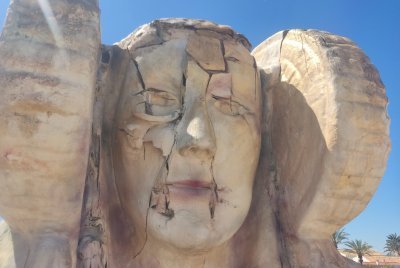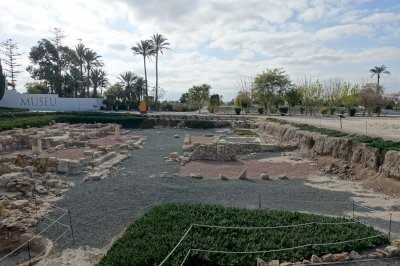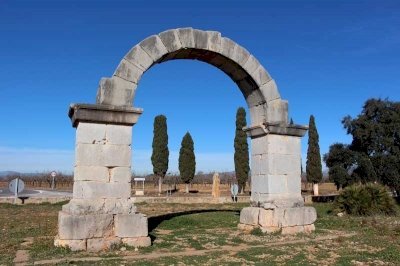Spain
Roman Ways. Itineraries of the Roman Empire
Roman roads were built from around 300 BC and were an important infrastructure for the expansion and maintenance of the Roman Empire. In Spain, the longest and most important Roman road was the Via Augusta, which connected the Pyrenees along the Mediterranean coast with Gades, the present-day Cadiz. Visible remains related to the Via Augusta are the Arc de Berà (Tarraco WHS), Arc de Cabanes, Castillo de Sagunto and the necropolis and amphitheatre in Carmona.
Site Info
Official Information
- Full Name
- Roman Ways. Itineraries of the Roman Empire (ID: 5130)
- Country
- Spain
- Status
-
On tentative list 2007
Site history
History of Roman Ways. Itineraries of the Roman Empire
- 2013: Incomplete - not examined
- 2007: Added to Tentative List
- Added to tentative list
- Type
- Cultural
- Criteria
Links
- UNESCO
- whc.unesco.org
All Links
UNESCO.org
- whc.unesco.org — whc.unesco.org
Community Information
- Community Category
- Archaeological site: Ancient Rome
Travel Information
Recent Connections
News
No news.
Recent Visitors
Visitors of Roman Ways. Itineraries of the Roman Empire
- aleserre
- Alexander Lehmann
- Alikander99
- Allan Berry
- Ammon Watkins
- Argo
- Bram de Bruin
- Caspar
- Christoph
- Christravelblog
- Clyde
- CugelVance
- Daniel Chazad
- David Aaronson
- David Berlanda
- Dimitar Krastev
- Dirk-pieter
- Errol Neo
- GeorgeIng61
- Jasam
- Javier Coro
- Jonas Kremer
- Lisu Marian
- M. Huineman
- MMM
- nan
- Nick M
- Persian Globetrotter
- Philipp Peterer
- Roman Bruehwiler
- scubarrie
- Sergio Arjona
- sncjob
- Solivagant
- Svein Elias
- Szucs Tamas
- Thomas Buechler
- Tim Allen
Community Reviews
Show full reviewsCugelVance
Roman Ways. Itineraries of the Roman Empire
Roman Ways. Itineraries of the Roman Empire (On tentative list)

I visited the archaeological site of the ancient Ilici -nowadays known under its arabic name, " La Alcudia",the hill- on tuesday,the 21st of may 2024.
The location is approximately 4 km from Elche's city centre
The entrance fee is 5€ and the archaeological site is open from tuesday to sunday, from 9.30 am till 03.00 (15.00)pm ,closed on mondays.
After having had a coffee and a light breakfast in one of Elche's countless bars in its city centre I walked along the river bed till I reached the avenida de Ramon Pastor,there I turned left and within a few minutes I arrived at Lidl,a german supermarket,where I bought a bottle of water and a snack. I then followed the carretera Elche-Dolores till I reached the archaeological site " La Alcudia,where the known and famous Lady of Elche was discovered.
The way along the carretera was not as pleasant as along the river bed but there was no heavy traffic and palm trees could be seen everywhere.
I truly enjoyed my walk to the archaeological site.....even carrying my bag with me. I left my bag at the reception inside the interpretation centre and followed the proposed path through the premises. First to the fragment of the roman wall,then to the western thermal baths,then to the iberian houses,from there to the drainage,then to the wealthy roman homes(domus),from there to the goldsmith's house,then to the central area(the heart of the roman city,so to speak),then to the museum(more than …
Keep reading 0 commentsnan
Roman Ways. Itineraries of the Roman Empire by Nan
Roman Ways. Itineraries of the Roman Empire (On tentative list)

A few kilometers South of Elche lies the archaeological area named L’Alcudia. Alcudia is the Moorish name of the hill where the original Roman colony named Ilici was situated.
The site was settled already in pre-Roman times and grew under the Romans as it was designated as Colonia Iulia Ilici Augusta. Veteran soldiers of Augustus campaigns settled here. After the Roman period the Visigoths and the Byzantines controlled the town. Consequently, there are some paleo-Christian ruins on the site. After the Moors took over, they set up a separate town further north (modern day Elche) and the original town was mostly disbanded over time.
While the site does not hold any spectacular ruins, the onsite museums are quite nice and provide much needed background. The most notable find on display is a copy of the Lady of Elche, a pre-Roman bust with a very distinctive hairdo. The original is shown in Madrid.
By spanning so many periods the site enriches the history of nearby Elche, so I enjoyed visiting.
OUV
Having only seen Alcudia I can't fully judge the nomination. Alcudia certainly has regional and potentially national significance but no OUV.
If Alcudia is representative of the whole, then this is an assortment of mediocre Roman ruins. The goal here is to create OUV by finding strength in numbers; I hope this fails. In Tarragona there is already a similar site from the same region inscribed which also happened to be …
Keep reading 0 commentsPhilipp Peterer
Roman Ways. Itineraries of the Roman Empire
Roman Ways. Itineraries of the Roman Empire (On tentative list)

I visited 2 components of this site. The nomination is focused on the Via Augusta but contrary to other routes, like the Camino Real in Mexico or the Routes to Santiago, they are mostly talking about the street itself and not the stations in between. Too bad basically none of the street is left. I visited Sagunt, around 25mins from Valencia. In itself a town of historical significance, as it was an important Roman town and it was conquered by Hannibal on his way to Rome. The fortress (built by the Romans and extended by the Moors) is massive and visible from far away. Not too much of the Roman infrastructure is left though. Same goes for the Roman Theatre next to the fortress that has been heavily desecrated with modern infrastructure in order to keep using it as a theatre. It’s a shame, compared to the theatres I saw in Orange, Mérida or Dougga. All in all a nice enough town for a stop, but not especially for the Roman sites.
The second component I visited was the Arc de Cabanes. It is a triumphal arc in the size of the bigger door. The fact that they built a road around the arc makes it appear rather like a nice roundabout decoration than an actual archaeological site. At least there is an information panel about the Via Augusta close to the arch.
There might be more interesting components of this TWHS, but from what I saw it …
Keep reading 0 comments